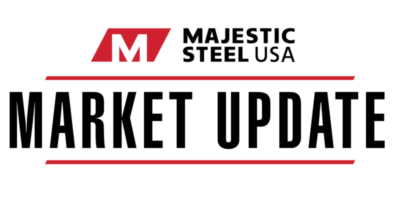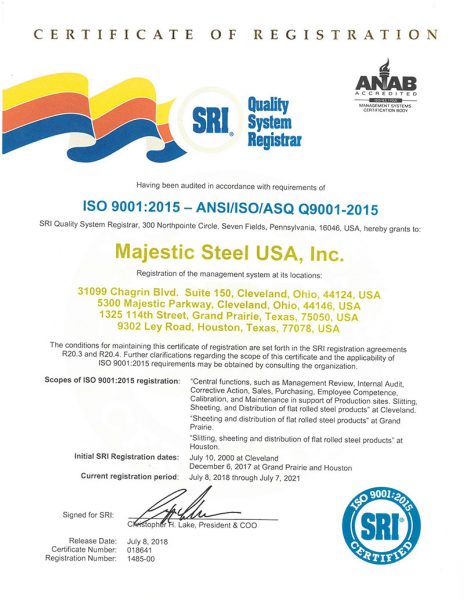Market Update | November 2, 2022
TOTAL CONSTRUCTION SPENDING ON THE RISE
After sliding for the first time in nearly a year in August, total construction spending increased slightly in September. Total construction spending came in at a $1.811 trillion rate, up 0.2% from August and up 10.9% on a year-over-year basis. Nonresidential spending increased 0.5% to a $883.9 billion rate, its highest level on record. Despite the higher percentage increase in non-residential spending, the current ratio of overall spending favors residential at a 51.2% to 48.8% clip.
Input Costs
The recent up and down movement for zinc continued this week, as pricing dropped after a slight increase last week.
-
-
Zinc pricing came in at $1.24/lb this week, remaining below $1.50/lb for the eighth straight week.
-
Spot iron ore pricing is down sharply this week, sliding to $80.15/mt this week.
-
-
This is down 10.4% from the end of last week and is down 15.9% on a m/m basis.
- Bearish conditions, recession risks and slowdowns in China, will likely affect the steel industry during Q4 and thus limit iron ore demand.
-
Pacific Basin met coal pricing rebounded again this week, climbing to $311.50/mt.
-
-
Current pricing is up 4.2% from the end of last week and up 16.9% from this time last month.
-
Supply
Domestic raw steel production declined once again last week and is now down for the second consecutive week.
-
- U.S. steelmakers produced 1.663 million tons at an 74.5% utilization rate.
- This was the lowest weekly output since the first week of 2021.
- YTD production is now down 4.7% from the same time last year.
DEMAND
After sliding for the first time in nearly a year in August, total construction spending increased slightly in September.
-
-
Total construction spending came in at a $1.811 trillion rate, up 0.2% from August and up 10.9% on a year-over-year basis.
-
While residential construction spending was virtually flat from August, non-residential spending saw an increase.
- Non-residential spending increased 0.5% to a $883.9 billion rate, its highest level on record.
- Despite the higher percentage increase in non-residential spending, the current ratio of overall spending favors residential at a 51.2% to 48.8% clip.
-
The decline in manufacturing activity, in the Chicago region, accelerated in October.
-
-
The October Chicago PMI came in at 45.2, down from 45.7 in September and is at its lowest level since June 2020.
-
Any reading under 50.0 denotes contraction, while any reading over 50.0 shows expansion in activity.
- Despite stronger readings from the order backlog and employment components, declines in new orders and deliveries more than offset the gains.
- The new orders component contracted for the fifth consecutive month, sliding to 39.2; its lowest reading since the onset of the pandemic.
- The production component, while still contracting, improved slightly to 45.1 in October.
-
National economic activity, from the manufacturing sector, grew slightly in October.
-
-
The National ISM Manufacturing Index came in at 50.2, down slightly from 50.9 in September and is down from 60.8 last October.
- Despite the recent slowdown, the index has been in growth territory for twenty-nine consecutive months.
- Any reading over 50 indicates growth, while any reading below 50 denotes contraction.
- While still contracting, the new order component saw the largest increase in October.
- The biggest slowdown came from the backlog of orders component, which saw the index sliding from 50.9 to 45.3.
-
U.S. light vehicle sales increased in October after sliding the previous two months.
-
-
U.S. sales totaled 1.152 million units, up 2.9% from September and up a strong 9.6% from 1.051 million units in October 2021.
- Sales have now increased, on a year-over-year basis, for three consecutive months.
- Sales of both cars and light trucks increased in October, with car sales climbing more than 5.0%.
- Car sales have now increased in three consecutive months.
- Light truck sales were up 2.5% from September and at their highest monthly total since April.
- Year-to-date light vehicle sales are still down 11.2% compared to the same timeframe last year however.
-
This material, information and analyses (the “Content”) may include certain statements, estimates and projections prepared with respect to, among other things, historical data and anticipated performance. Content may reflect various assumptions by Majestic Steel USA, Inc. concerning anticipated results that are inherently subject to significant economic, competitive and other uncertainties and contingencies and have been included for illustrative purposes. Content is provided AS-IS.

